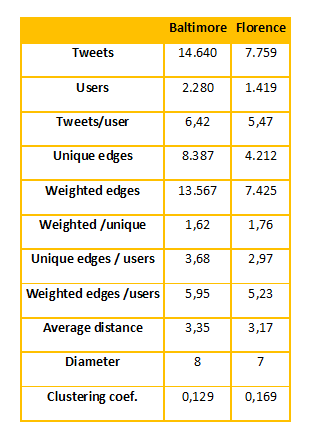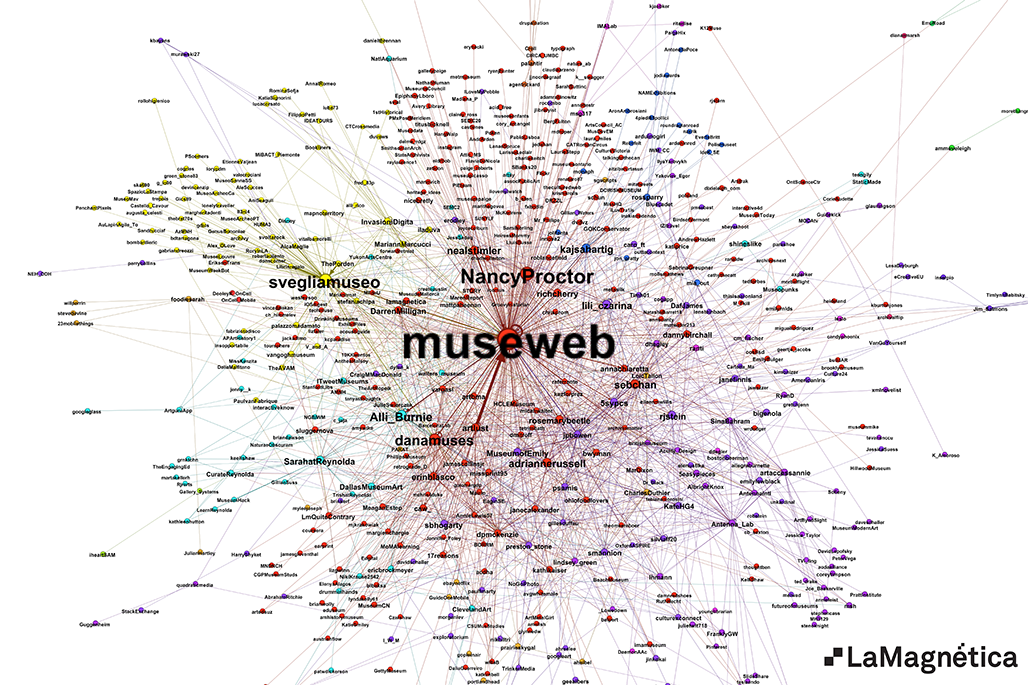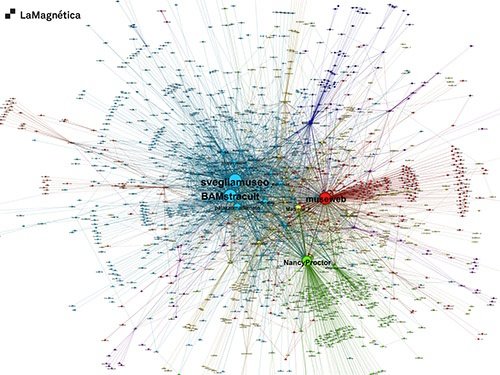Here you have a high-resolution image of the grap: Download
Here you have a high-resolution image of the grap: Download
The comparison between the Twitter results regarding Baltimore MW2014 and its European edition held in Florence generates some interesting results.
Results
The following table includes some technical variables that define the Twitter graphs of the two conferences, and help us to analyze the differences in relationships patterns and conference repercussion. If the table looks to technical for you, you can skip it. This post is devoted to explain these differences in a non-technical language.

The dimension of the Baltimore Congress on Twitter is bigger: more tweets (almost double), more users tweeting and a higher average of tweets per user. There were probably more tweets without the hashtag in Baltimore (mainly replies or tweets intended for a particular user) but there is no easy way to prove it. It more an intuition arisen during the conference browsing Twitter timelines and following conversations, than something we can prove.
The amount of mentions (totals and unique) was also higher, approximately twice.
And the number of connections per user was also higher 3.68 vs. 2.97. This might be caused by the fact that the network of previous connections to the conference is higher in the case of USA, which should not be surprising as the conference has been going on for almost 20 years while its European version has taken place for the first time. The diversity of the countries and languages in Europe is also part of the reason.
The Florence conference, on the other hand, had more repeated mentions. This might be attributed to the group of active participants, including some bloggers.
In the case of Baltimore, the average distance and the diameter are bigger, which is normal because we are talking about a larger graph: 60% more users and 90% more tweets.
A difference that stands out is the clustering coefficient, which is significantly bigger in the case of Florence (0.17 vs. 0.13). This is reflected when we compare the images of the graphs involved in the conference.
In the case of Baltimore, @museweb holds the leading position and keeps a large distance away from the following account (important ones mentioned only):@nancyprctor, @svegliamuseo, @nealstimler y @danamuses, which form group structures with the accounts that are near to them.
In the Florence conference, the structure of the graph is much more marked, and various groups which are obviously different and dense can be distinguished. We didn’t observe it in the case of Baltimore (except for the Italian group, which is connected by @svegliamuseo):
- An Italian group which occupies almost half of the graph is the one leaded by @BAMstracult, @svegliamuseo and @palazzomadama.
- The Italian group was so active that @museweb was not the most important neither occupies a central position, despite being one of the main profiles,
- Other relevant groups were the North American, mostly surrounding @nancyproctor, and the Spanish group, surrounding @BNE_museo and @elenaruas, being the last one the link between the Spanish and the Italian group. There are other profiles like @Madlena o @nealstimeler who connect two or more groups.
This situation forms a contrast with the Baltimore graph, being @museweb in a central position and having a structure far more diffused.
The difference in clustering coefficient is due to two underlying reasons:
- The diversity of countries and languages involved in Florence.
- The fact that many attendees were establishing a Twitter network at that time. This was clear about many Italian museums and museum professionals that were quite new at Twitter at that time, and profited from the established connections of the more mature museums and users. This was not exclusive of Italian museums, but it was clearer in their case due to Twitter maturity and the large number of Italian attendees.
Other variables that we haven’t discussed showed similar values, or differences that are explained by the difference in the number of tweets about each conference.
Summary
To summarize,
- The Baltimore conference Twitter talk involved more tweets and users, which is no surprise.
- The Florence conference showed a more marked community structure due to language and country diversity, but also to the dynamics of community formation.
- As a result of the last point, the influencers had a more relevant role in Florence. The exception is Museum’s and the Web official profile.



